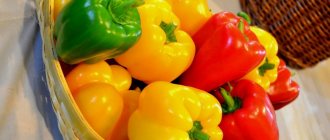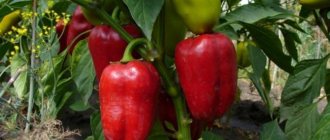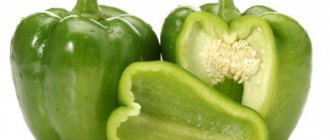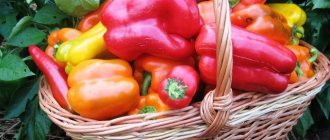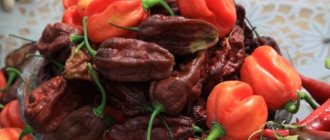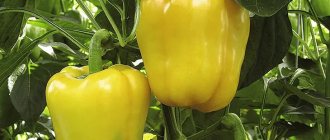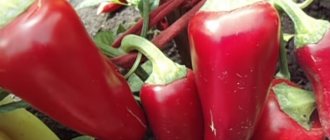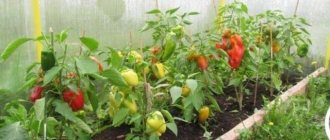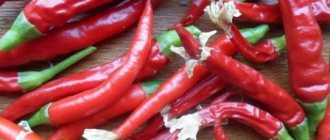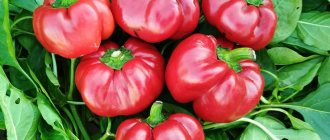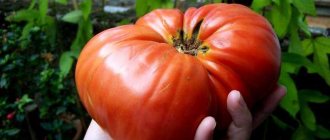Harvesting sweet peppers
The most pleasant moment for any gardener is the beginning of harvesting.
Ivanhoe peppers begin to ripen early (meaning the technical maturity of the fruit), and bear fruit for a long time. Fruits that have reached normal size can be removed and placed for ripening. ON A NOTE!
The state of technical maturity of the fruit indicates that the peppers have reached the required mass and ripeness to be used as food.
It is advisable not to wait for the peppers to fully ripen on the bush, as this reduces the overall yield. They do this only if they receive their own seeds from the fruit.
Harvesting is carried out regularly so as not to inhibit the growth of other fruits on the bushes.
Ivanhoe branches are characterized by increased fragility, so you need to be very careful when harvesting peppers, use pruning shears or a knife.
Reviews from gardeners
Natalie, 45 years old : “Ivanhoe is one of the most aromatic and delicious varieties of pepper. I freeze it, can it, and add it to various dishes. I have never met a tastier pepper than it. I recommend everyone to plant this particular pepper in their summer cottage.”
Vasily, 52 years old : “I do not accept any chemical treatments and believe that pepper fruits absorb all the harmful substances that then enter our bodies with vegetables, and there are already a lot of all sorts of chemicals in our lives. This same variety is very resistant to various diseases, and for several years now, without any treatments, I have been harvesting simply an excellent, rich and tasty harvest of Ivanhoe pepper. I recommend this variety to everyone, you won’t have any problems with it.”
Lyudmila, 47 years old : “At first my friendship with this variety did not work out, but later I realized that it was my own fault, since I like to water my crops with water directly from the well. And Ivanhoe does not like cold soil and water, so with these actions I slowed down the growth process of the plant. But then, when I read how to properly care for it, everything went like clockwork and I reaped a rich harvest.”
Nikolai, 60 years old : “I have a very small plot and I can’t plant a lot of vegetables, since I need to maintain a certain distance between the bushes. With this variety I can use the soil sparingly, since even when planted densely it bears fruit well. Ivanhoe is an ideal option for a small area.”
Dmitry, 56 years old : “I don’t want to bore anyone with long stories about growing this variety, so I’ll say it briefly and clearly. High yield, ease of care, charming taste. My grade rating is 5+.”
As you can see, many summer residents simply admire Ivanhoe pepper , so if you are thinking about what variety to plant on your plot, then you should definitely take a good look at Ivanhoe.
It will not cause you problems and you will easily reap a rich harvest that will delight you and your loved ones.
Ivanhoe pepper has a pleasant taste and decent yields, which is why it is popular among gardeners.
How to care outdoors
It is not difficult to care for Ivanhoe, despite its southern roots, this plant does not require individual conditions for itself, therefore it can be safely cultivated using standard agricultural techniques for growing crops
In this case, special attention should be paid to the maintenance regime of the beds
Watering
Peppers are watered regularly; this crop does not tolerate drought, so if there is a lack of free moisture, it may die. To avoid this, a regular irrigation system is created on the site; for this, during periods of drought, the beds are watered at least 2 times a week; during rainy periods and in cold weather, the frequency of the procedure is reduced. A clear sign of the need for watering in the beds is a dense, dry soil crust, 2–4 cm thick.
Peppers are watered using the drip irrigation method; the most favorable period for this is considered to be early morning or late evening. This is the only way to protect against excessive evaporation of moisture and irrational watering. To do this, use only clean, pre-settled water. It should be heated to ambient temperature, otherwise there is a high probability of frostbite of the pepper root system.
Read more about how to water peppers correctly and how often.
Soil care
For successful growth, pepper requires timely weeding, loosening of the soil, and mulching. Loosening and weeding are often combined; they are carried out as needed, but not earlier than once a week. Additionally, the soil is loosened the next day after watering and heavy rains. In this case, it is possible to avoid the development of weeds in the beds, and also to give the soil the necessary gas permeability. At the same time, in order not to damage the root system of the pepper, loosen the soil by 4-5 cm.
Mulching is mandatory for all gardeners who are trying to create the most favorable conditions for Ivanhoe on the site. It makes it possible to retain valuable moisture in the soil, as well as create an optimal microclimate and temperature regime. The procedure is carried out at least 2 times per season, 2 weeks after planting and before flowering. Coconut coir, sawdust, pine needles and pine bark are used as mulch. The thickness of this layer must be at least 5 cm.
Did you know? Despite the same root name, capsicum is not a related species to peppercorns. They belong to a separate family, Pepperaceae, while capsicums are a member of the Solanaceae family.
Fertilizer application
If the site is properly prepared, the application of additional fertilizers is not necessary, but often this measure increases the yield several times and helps to shorten the ripening period of fruits by 10–14 days. To do this, fertilizing is carried out systematically, according to the following scheme:
- 14–25 days after planting, the beds are watered with phosphate-nitrogen solutions (25 g of superphosphate, 10 g of urea/10 l of water);
- During flowering, boron compounds are useful; for this, a sugar-boron mixture is used (500 g of sugar, 20 g of boric acid/10 l of water);
- after the ovary appears, the beds are watered with a solution of sodium and ammonium (10 g of sodium nitrate, 5 g of ammonium sulfate/10 l of water);
- During the fruit-filling period, the plantings are fertilized twice with nitroammophos (10 g/10 l of water) and a mixture of 40 g of superphosphate and 20 g of potassium nitrate (per 10 l of water).
Garter bushes
Ivanhoe is considered a tall bush, so its plantings definitely need a garter. This procedure helps to avoid stem fragility during active plant growth, as well as during the fruit-filling phase. In addition, tied bushes become absolutely invulnerable to sharp gusts of wind, which often lead to overhanging plantings.
The garter is carried out as early as possible; it is best to do it after the seedlings have rooted, approximately 14 days after planting. Wood pegs or metal rods are used as support, which are installed at a distance of 10 cm from the bush. Tie the bushes to the support using tight twine, in the center or slightly above the center of the stem. In this case, the plant should be fixed freely, and the garter should not cause difficulties for growth.
It is useful to learn how to store peppers at home so that they turn red.
Ivanhoe is a modern, unpretentious, high-yielding variety capable of producing high-quality fruits. That is why this plant is often used for both home and industrial cultivation, including subsequent sale. Growing this pepper is not difficult, but for its growth and abundant fruiting you will need to create a stable microclimate and regular care, including timely feeding.
Pepper care
There are no special techniques in the agricultural technology of the Ivanhoe variety:
- regular watering;
- weeding;
- loosening;
- fertilizing
Water the plants, depending on the weather, at least twice a week. Sweet peppers do not like excess moisture, and they also do not tolerate drought. Therefore, it is advisable to water in a timely manner, only with warm and settled water.
It is necessary to ventilate the greenhouse so that the temperature on hot days does not exceed +30ºC.
Pepper supplements
In order for the harvest of sweet peppers to meet the declared characteristics, it is necessary to take care of “dinners” for the plants.
For fertilizing, it is convenient to use complex fertilizers, where the percentage of all components is known. During the first growing season, when pepper bushes are gaining growth, nitrogen fertilizers are indicated. During the budding phase, more phosphorus is added; at the beginning of fruiting, priority is given to potassium fertilizers.
Excellent results are obtained by dusting the beds with ash, as well as watering plants with infusions of ash. This allows you to provide the pepper with the necessary nutrients, and at the same time protect the crop from diseases and pests.
Description and characteristics of the variety
The original variety of the series is Marconi Red pepper. It has not been tested in Russia, is not in the State Register, but is popular among amateurs.
Descriptions of the variety from different manufacturers, reviews from gardeners characterize Marconi Red as a pepper of both early and medium ripening. In fact, it is early ripening, the confusion could have occurred for two reasons:
- Tomatoes in Russian gardens are grown more often and in larger volumes than peppers. Closely related cultures. Marconi ripens 100-115 days after germination, which exactly coincides with the start of fruiting of mid-ripening tomatoes.
- Early pepper takes 90-110 days to color, average pepper needs 110-130. Marconi occupies an intermediate position, but still closer to precocity. And the variety is imported, and is positioned by foreign sources as early.
Marconi pepper forms a medium-sized bush, the height of which reaches:
- in open ground – 50-60 cm;
- when grown in greenhouses 70 cm, with intensive fertilizing and abuse of nitrogen - up to 1 m.
The leaves are medium sized, not too dense. The shoots cannot withstand the load of fruit, they break, and require pinching and tying to a strong support.
Peppers are large, up to 20 cm in size with a diameter of 5-7 cm, a wall thickness of 4-6 mm, weight - 150-200 g, individual fruits reach a weight of 300 g. They should ideally be long and narrow, with a sharp nose, similar for bitter varieties, only big ones. In practice, the pods often grow flattened, sometimes curved, making them appear wider. But, as you can see in the photo, they don’t look ugly, but exotic.
At technical ripeness, Marconi fruits are green. They can already be eaten, which is rare for thick-walled peppers, which are usually inedible before coloring. When fully ripe, the skin is deep red and shiny, the taste becomes very sweet, and the flesh is juicy.
From one square meter per season, 7-8 kg of fruits are collected in open beds and under film, in greenhouses - about 10 kg of fruits.
The harvest can be harvested as soon as the first strokes of the main color appear on the pods. But gourmets claim that when the peppers are fully ripe on the bush, they become especially tasty - a smoky aroma appears and the sugar content increases. The pods are eaten fresh, stuffed, grilled and baked in the oven. They can be stewed, fried, boiled, used for winter preparations, or frozen.
As Marconi pods mature, they become tastier but become increasingly flattened. For stuffing, it is recommended to use peppers at the stage of technical maturity (green).
"Knight" in your greenhouse
This is a semi-standard plant (usually forms one or two stems), a fairly compact plant, which is intended for growing in greenhouses. Ivanhoe is also grown in open ridges, but not always in Russian conditions (regions of the Urals, Siberia, North-West) the summer season is warm, and you can be left without a harvest.
The variety is early, before harvesting fruits of technical maturity you will have to wait about 100-110 days from the moment of germination. The leaves are beautiful, ovoid in shape.
Ivanhoe's fruits are cone-shaped and have thick, fleshy walls. Thickness – about 6-7 mm. The weight of peppers is up to 120-140 grams. There are two or three chambers inside, the seeds are quite large. The pepper pulp is juicy, aromatic, and has high taste qualities.
ON A NOTE! During the period of technical maturity, this pepper has a beautiful cream color, and at biological maturity it is bright red.
It is used for stuffing (many people specially grow “cone-shaped” peppers), preparing salads, as well as various preparations. Ivanhoe pepper is disease-resistant, for which it is valued by gardeners from risky farming regions.
Description of Ivanhoe pepper and its characteristics
Ivanhoe is a new hybrid of bell pepper, bred by Ukrainian breeders of the Nasko agricultural company at the beginning of this century. In the southern regions, the variety is cultivated in open ground, but in more temperate climates the hybrid can only grow in film conditions, since the only drawback of this variety is its vulnerability to adverse weather conditions. It is popular not only in its homeland, Ukraine, but also in Russia. Distributed throughout our country.
What does a bush look like?
The hybrid plant is compact but strong:
- the bush does not grow higher than 50-70 cm;
- the main stem is powerful and thick;
- the leaves of the hybrid are medium in size, dark green in color, slightly wrinkled;
- bush - slightly spreading, medium leafy, medium vigor, does not require formation;
- flowers are medium size, white.
What are the fruits?
Peppers usually grow to medium sizes:
- the weight of one varies from 90 to 140 g;
- the shape of the peppers is cone, the color of ripe fruits is red;
- the fruits of the Ivanhoe hybrid are characterized by a thick wall - 7-9 cm;
- the surface of the fruit is smooth and shiny;
- the pulp is very juicy and crispy, covered with a dense thin skin;
- The taste is wonderful, richly sweet.
Chemical composition of bell pepper and its benefits
Bell pepper is a valuable vegetable, which contains many beneficial components for our body. Pepper is rich:
- vitamins A, group B, C, E, PP;
- micro- and macrocomponents;
- essential oils;
- organic acids;
- fatty acids;
- amino acids;
- antioxidants;
- monosaccharides;
- alkaloids;
- fiber and pectin;
- nitrogenous compounds, etc.
Due to the high content of vitamin C, pepper helps restore immunity and is excellent at fighting colds and viral diseases. Also, constant consumption of bell pepper in food helps to remove toxins, toxic substances and heavy metal salts from the body, block free radicals, normalize blood sugar and cholesterol levels, and lower blood pressure in hypertensive patients.
Pepper has a mild diuretic and laxative effect, is useful for diseases of the kidneys, liver and gall bladder, it prevents the formation of blood clots in atherosclerosis. The vegetable is recommended as a dietary product for diseases of the heart and blood vessels, in particular for coronary heart disease and angina.
Since the product contains a minimum of calories and the component capsaicin, a powerful fat burner, red bell pepper is widely used in weight loss diets. And these are not all the beneficial qualities of this unique vegetable. An entire article would not be enough to list them.
Application
Bell peppers are most useful when eaten fresh. You can also use it to prepare a variety of pickles for the winter - pickled peppers, lecho, various canned salads and snacks that include this tasty and healthy vegetable. Peppers are frozen, dried, dried, baked, pickled, stuffed, fried, fermented, etc. There are so many recipes for dishes that can be prepared from this unique culture that it is simply impossible to describe everything.
Yield indicator
Ivanhoe is a high-yielding hybrid that produces stable high yields, the performance of which does not depend on almost any factor, except perhaps on weather conditions, but this does not apply to the greenhouse method of cultivating the crop. With quality care, you can get 6-8 kg of high-quality fruits from one square meter, and with mass cultivation from one hectare - up to 70 centners of tasty, healthy peppers.
When it starts to ripen
This variety is early ripening. Its growing season is 120-130 days from the moment the first shoots appear. It is after so many days that the fruits ripen completely and turn red. The hybrid reaches technical maturity after 100-110 days, that is, such peppers can already be used for food and for preparations.
Shelf life and transportation options
Ivanhoe fruits have a long shelf life and tolerate transportation well. The hybrid is very popular among farmers who are happy to cultivate it for mass marketing. The variety is also popular among buyers due to its excellent taste, presentable presentation, and impressive wall thickness.
Reviews
With this variety we always have a harvest. I have a small plot, but I want to grow a lot of things. I plant three varieties of peppers and Ivanhoe is one of my favorites. Very tasty fruits.
This variety was recommended to me by a salesperson in a store. I took it and did not regret it - the fruits are delicious, the bushes are small. I grow peppers in a special greenhouse near the wall of the house. There are no problems with the garter, diseases, and for two years now Ivanhoe has been among my favorites. I use it only fresh, I haven’t used it for seaming.
Nikolay, Leningrad region
I won’t bore you with descriptions of how to care for this variety. The variety is productive, problem-free, the peppers are tasty and what we all especially like is that they have thick walls. I didn’t regret that I bought these seeds three years ago (and I liked the name); now I have my own seeds from ripened fruits. I plant them as seedlings.
Packaging of early Ivanhoe pepper
| 40 seeds. |
Brief characteristics of Ivanhoe pepper:
- The shape and height of the plant is medium-sized, compact, semi-standard.
- The period from germination to technical ripeness of the fruit is 105-115 days.
- The period from germination to biological ripeness of the fruit is 125-135 days.
- The fruits are cone-shaped, 2-3 chambered.
- When technically ripe, the fruits are white-cream in color.
- At biological ripeness, the fruits are bright red.
- The average fruit weight is 95-140 g.
- The thickness of the fruit wall is 4.0-7.0 mm.
- The yield of the early variety of sweet pepper Ivanhoe is 70-80 t/ha.
- Plant density (recommended) - 70-80 thousand plants/ha (depending on the seedling planting scheme).
In the professional series, the seeds of the Nasko company are calibrated, which allows the use of precision seeders when sowing seeds. which allows you to save on seed material.
You can find recommendations for growing peppers in the “Recommendations” section - Recommendations for growing sweet peppers from the Nasco company.
NASKO Pepper Comparison Chart
* Nasko company reserves the right to make changes to current information (fractions, batches, storage dates) posted on the front side of the package or can without prior notice
Typical diseases and pests
To reduce the likelihood of pepper infection, follow the rules of prevention:
- processing of garden tools, containers and soil;
- compliance with watering rules;
- regular loosening of the beds;
- weed removal;
- compliance with crop rotation rules.
To protect against insects, use special preparations (“Barrier”) or home remedies:
- Wormwood decoction. Finely chop the wormwood and fill ¼ of the bucket with the grass. The rest of the volume is filled with boiling water. When the liquid has cooled, it is filtered and used for spraying. Other bitter plants will also work.
- Soap solution. A piece of laundry soap is rubbed and dissolved in a bucket of water. If desired, add 1 chopped onion.
- Serum. Whey (or other fermented milk products) is diluted with water in a ratio of 1:5.
- Ash or tobacco. Leaves and beds are sprinkled with powder.
Similar varieties and hybrids
The early ripening variety of sweet pepper Freckle is good, but it is not always easy to find seeds on sale. And hybridity does not allow you to independently prepare seeds that will preserve the advantages of the mother bush. Therefore, plants can be replaced with the following analogues:
- The Big Mama variety is a representative of a group created by agro to increase the color range of the crop. This pepper is characterized by the orange color of fruits that are at the stage of biological ripeness. Semi-spreading bushes reach a height of 0.6-0.7 m in open ground. Growing is possible in all regions of Russia. Some gardeners consider the variety to be early, others – mid-season, since the growing season lasts about 120 days. Plant productivity is lower than that of Freckles. You can harvest 7 kg of pepper per square meter. Each thick-walled fruit weighs 120-150 g.
- Allar pepper from agro is also characterized by large orange fruits. The bushes grow on any type of soil, the degree of protection of which depends on the climate zone. The height of pepper is 0.4-.05 m. The short growing season lasts 90-100 days. Plants require formation by removing stepsons and lower leaves. The shape of the fruit is more like a cube, and the walls are even thicker than those of Freckles. If fertilizing is available, up to 12 kg of crop is harvested per square meter. Peppers gain about 200-240 g of weight.
- Pepper Orange Bull belongs to the authorship of selectors from “Russian Hero”. Semi-spreading bushes are considered tall, as they reach 0.8-1.1 m, and therefore require staking to a support. The variety can be grown in closed or open ground, but the yield is higher when planted in a greenhouse. From 7 to 14 kg of fruits are collected per square meter, each of which weighs at least 200 g, and sometimes even 400 g. The walls of cube-shaped peppers are thick, and there is no bitterness in the pulp. The ripening period is 100-110 days, starting from the emergence of seedlings, which indicates mid-ripening.
Advantages and disadvantages
- Main advantages of Ivanhoe:
- short growing season;
- high productivity;
- the plant is not afraid of dense plantings;
- fruits tolerate long-term storage and transportation;
- excellent taste characteristics of the fruit;
- the variety is resistant to specific infections, including Alternaria and viral mosaic;
- peppers are completely ready for consumption even in the technical maturity phase.
This pepper has only one drawback, however, it is quite significant. The plant does not tolerate sudden cold snaps and changes in weather conditions, this leads to its inhibition and all kinds of damage to the fruit. Therefore, in regions with unstable climatic conditions, it is grown only in a greenhouse.
Planting dates and care features
Seeds tend to hatch unevenly - from 2 weeks to a month. Sowing for planting in greenhouses is done:
- south – early February;
- Middle zone - mid-late February;
- regions with cold climates - from late February to early March.
For peppers grown in open ground or under film, the timing is moved closer to warmth by 10-14 days. Thick-walled varieties are recommended to be planted approximately 60 days after germination, when the soil warms up:
- for greenhouses – up to 10° C;
- to the garden - at 15° C.
Seeds coated with a shell are planted dry to a depth of about 3 cm, untreated - after disinfection and soaking.
It is not recommended to germinate peppers - the roots are too fragile, the grains will have to be moved into the container one at a time, using tweezers or another device.
If the seeds are sown in individual containers, they remain there - the culture does not like transplants. Picking from common boxes is carried out in the phase of 2 true leaves, to the same depth. Pepper does not form additional roots on the stem. Deepening will lead to its rotting.
You can plant 2 sprouts into individual containers, especially when growing the Orange miracle in open ground. In this case, the yield will decrease slightly, since the feeding area will decrease, but care will be significantly simplified. The likelihood that strong gusts of wind will break the main shoot is reduced - the hybrid is quite tall, the bushes will support each other in addition to the garter.
Caring for seedlings after picking involves timely watering and fertilizing. They are given twice during the normal development of seedlings, or in a highly diluted form each time the substrate is moistened. Illuminated up to 6-8 hours a day.
The top is not cut off. This will cause the seedlings to bush, which will have to be corrected during formation, and also delays the onset of fruiting. There will be no talk of any early harvest, which will hit farmers especially hard in the pocket.
2 weeks before moving to a permanent place, the peppers are hardened. By this time, the stems should have 8 or 10 leaves. When transplanting, they try to disturb the earthen ball as little as possible; the peppers are not buried.
When planting, it should be taken into account that pepper needs 6-8 hours of sun per day and protection from strong winds. Further care is as follows:
- Regular but moderate watering. The soil should not dry out, but water stagnation should not be allowed. The next day after rain or watering, it is recommended to loosen the soil between the rows.
- Careful feeding. Peppers react poorly to excess fertilizers, especially nitrogen, and begin to get sick. Nitrates should predominate in fertilizing during the first half of the growing season, then the emphasis is on potassium. The crop needs little phosphorus.
- Bush formation. The orange miracle is an indeterminate hybrid; it is grown in 2-3 trunks in the garden; it is allowed to leave 1 in the greenhouse to obtain especially large fruits. The bush must be tied to a strong support, and the top is pinched 1.5 months before the expected end of the growing season.
- Harvesting. The fruits are picked when a few streaks of orange appear on the dark green pods. They will arrive in storage. Vegetables collected at the stage of technical ripeness are tasteless and poorly ripened. If you allow the fruits to fully color on the bush, they will be especially fragrant, but the ripening of other peppers will be slowed down.
Features of growing the variety
The pepper does not need shaping.
Its high productivity is ensured by its branching. Once a week, the lower part of the bush is cleared of excess foliage. Yellowed and withered greens are also removed.
After each watering, the soil must be loosened
It is important to clear it of weeds in a timely manner.
Ivanhoe is characterized by low resistance to cold weather. When grown in open ground, during the first 2 weeks after planting in a permanent place, as well as during cold weather, it is covered with film at night.
Picking to a permanent place
Pepper beds should be well lit by the sun. They are not located in areas with close groundwater.
When choosing a place to grow, it is important to pay attention to what plants have grown there previously. The soil on which nightshade crops have grown for the past two seasons will not be suitable. In the beds after legumes, melons and cabbage, the variety will feel best
In the beds after legumes, melons and cabbage, the variety will feel best.
Soil preparation rules:
- In the fall, pepper beds are dug to a depth of 20 cm. They are cleared of plant debris. The grass that is collected from the beds does not have to be thrown away. It is much more useful to crush it, treat it with a solution of potassium permanganate and bury it in the same area. This will make the soil more fertile. The soil is also mixed with rotted manure in a volume of 6 kg per 1 sq. m.
- In the spring, the beds are dug up or leveled with a rake and watered with a strong solution of copper sulfate.
- Pepper does not like acidic soils. To make the soil slightly acidic, it is mixed with dry lime or ash.
- If the soil is heavy, sand must be added to the top layer. Otherwise, the pepper will die.
It is better to dig holes in a checkerboard pattern. This way you can save more space. For planting this variety, a 50x40 pattern is used.
If the seedlings were grown in a peat container, then they are not removed, but rather destroyed a little. Peppers will have to be removed from plastic pots. It is planted in the holes, carefully straightening the roots. The root collar is not buried. The depression is filled with soil, which is compacted. Water the pepper using 1 liter of water for each plant.
Before planting peppers, it is useful to pour fertilizer into the holes. For example, long lasting granules, ash or small raw fish.
Transplanting
The time for planting peppers in a permanent place is determined by many factors:
- climate of the region;
- weather conditions of a particular season;
- condition of the seedlings.
The soil must warm up to +16-18ºC, otherwise the peppers will be cold. Typically, the Ivanhoe variety is planted in the ground at the end of May or beginning of June (middle zone), when the danger of returning cold weather has passed.
You can add humus and superphosphate to the holes, then plant the peppers, carefully sprinkling the roots with soil.
The distance between the holes for the Ivanhoe pepper variety is up to 30 cm.
